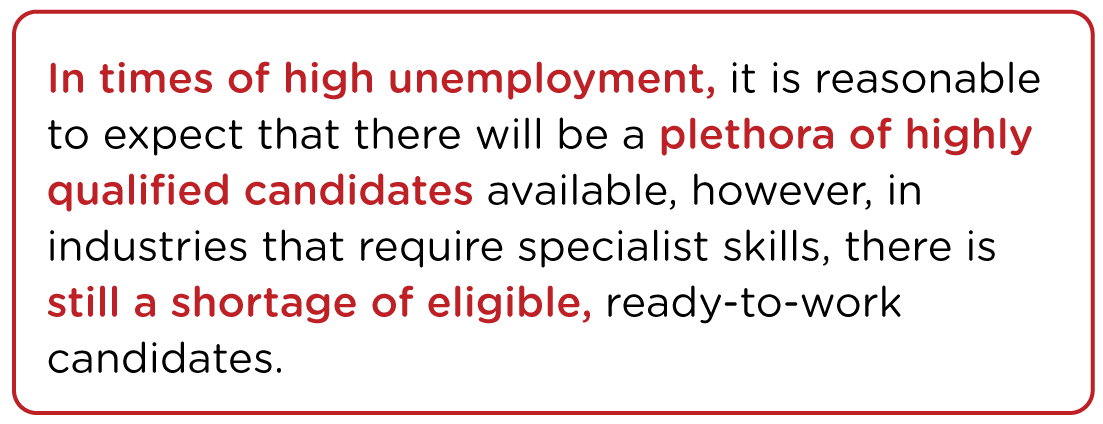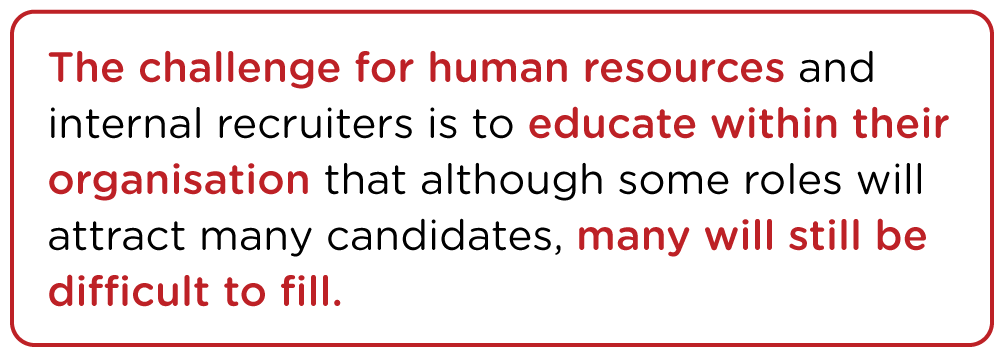Hard-to-Fill Roles in High Unemployment: Hiring During COVID-19
Skill gaps persist: Despite high unemployment, skill gaps persist and there will continue to be many hard-to-fill roles. Candidates with these in-demand skills will still be able to demand high salaries and will have a choice of roles. Be careful not to fall into the belief that higher unemployment means more candidates for every role – it doesn’t.
Exactly how high is unemployment right now? At the time I write this, the latest data from the Australian Bureau of Statistics reveals that unemployment is at 7.1% in Australia. However, when you take into account that very few job seekers and employees receiving JobKeeper payments are included in that number, it’s clear that the official statistic is skewed. You are not counted in this data if you work one hour in the week prior to the survey, if you are not ready to start work in the week after the survey period, if you have been stood down, if you have recently taken a week or two of annual leave, or if you have been laid off but believe you will get a job within four weeks.
With these caveats in mind, it’s safe to say that the real unemployment figure is probably closer to 20%.
If we look at New Zealand, the official unemployment rate is 4.2% – again, this is seriously understating the real figure. Just like in Australia, New Zealand’s wage subsidies are carrying a significant proportion of the working population, meaning unemployment in this country is likely closer to 10% than the official figure.
Employer Expectations
In times of high unemployment, it is reasonable for hiring companies to expect that there will be a plethora of highly qualified candidates ready to work right now. This is certainly the case for many roles, particularly those with lower skill requirements or in industries where there is a low barrier to entry.

So, as unemployment rises and sectors of the employment market become candidate-rich for hirers, it is almost like a two-speed economy. On the one hand, many of the vacancies will attract large numbers of talented candidates; we are already seeing 1000% increases in applications. On the other hand, some of the roles being hired for will still have very few candidates (again, this is evident).
Attracting Qualified Talent
In the current market, employers will need to be very clear on which category their roles fall into – i.e. are they likely to have many highly skilled candidates apply or very few applications?
Why?

For these roles, the age-old adage of “money talks” still applies just as it has in times of low unemployment, and being able to achieve the right balance in remuneration will be necessary if the organisation is to attract the talent they need.
There are many ways of doing this, the simplest being to advertise the roles and assess the responses received. Getting many qualified responses means there is an abundance of talent and competition for the role, which will generally indicate lower remuneration, within reason. But for hard-to-fill roles, there will be a much less qualified response, and salary will be the most effective way of attracting the talent required.
If you don’t want to spend time placing ads and processing responses, there will soon be another method you could use, with the recent announcement that Seek.com is changing its advertising fee structures.
In the past, Seek has charged a fee based on the number of advertisements purchased, whereas now the fee will be based on how difficult the role is to fill. The charge to the advertiser will be determined by Seek’s algorithms and will increase in relation to the difficulty of filling the role.
For the savvy recruiter, this means they can get a gauge of how difficult the role will be to fill by simply inquiring on the Seek website as to the cost of the advertisement itself, saving both time and money in placing an ad and filtering through the responses in order to gain the same understanding.
We are certainly in interesting times when the more you pay for an advertisement, the fewer responses you will receive. As a result, the support of a specialist recruiter will be invaluable for employers wanting to minimise the time and stress of finding qualified talent in a high unemployment market.
Feel free to reach out to our team to find out more about our recruitment services, and click here to read the first article in this series where I introduced the ten key challenges employers will face in a high unemployment environment.
Pete Davis is Managing Director of Frontline Recruitment Group (FRG). FRG is a specialist recruitment company with offices across Australia and New Zealand – they have been operating since the early 1990s and have worked in high unemployment environments with job hunters in many different industries. This blog series is about sharing some of the lessons from the past and integrating them with the technology and business practices of today. We hope you enjoy these articles and welcome your opinions.
Read more

